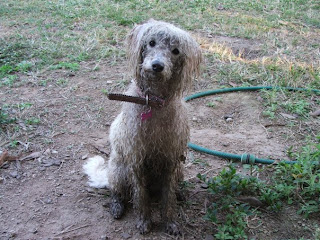 |
| A good spot to lie down. |
 |
| Mud is good. |
 |
| Prada looking a bit dirty. |
As the saying goes “Happy as a pig in mud”. The pigs love to cool off in the hot weather too and their favourite way is to wallow in a mud puddle. The definition in the dictionary of wallow is, to roll about with enjoyment; yep that’s what they do all right. I usually turn a hose on in the paddock to make their wallow area. As soon as they see me doing this they run up the paddock to investigate and then they are into it. Sometimes Prada our Miniture Poodle decides to join in with the fun and of course she throws her ball into the middle of mud and pigs and water. She never goes anywhere without this ball. The pigs are on familiar terms with our dogs and don’t mind them at all. The more the pigs get excited in the mud the more Prada throws her ball in and the more she gets wet from the hose and muddy from the puddle.
Watching the pigs in the mud you can see how much they really enjoy it. Sometimes they put their head in and then just slide the rest of their body along until they are lying down. Pigs don't really like the weather very hot, because they have very few sweat glands, actually they can hardly sweat at all. They are also not very good at getting rid of heat from their wet mucus membranes in the mouth by panting, as dogs do. When it comes down to it pigs are not very good at handling heat stress at all. The temperature where they are comfortable runs from 16 to 22°C. In commercial piggeries, when the temperature goes above this, water is dripped, sprayed or misted onto them, and fans are turned on to cool them down. Poor little darlings have no mud to wallow in. Our pigs are so lucky to be free range and have a whole paddock to run around in and a big mud puddle to wallow in. They are also lucky to have a warm and snug stable to go in and out of as they please with a big comfy bed of thick straw to lie down on.
Feeding time in the late afternoon is a sight to behold and the sounds that echo out are deafening. I always say it sounds like feeding time at the Zoo. The routine is to feed the pigs first because that gets them out of our way otherwise they get under foot. As soon as we arrive at the door of the stables they are there waiting and it’s a case of battling your way in past the pigs to get to the pig pellets to feed them. Once they are done (very quickly so they don’t knock you down trying to get to the scrap bucket and pellets) it’s on to the poultry. The chooks are first; they are no bother unless they get a bit too excited and go into the geese pen by mistake although that doesn’t happen much anymore. Then we feed the geese, they are the noisiest by far the sound is very loud. I always think to myself I must record this so our friends can hear sounds of the afternoon animal symphony of pigs, chooks and geese with the occasional dog bark. They all sound like they are as happy as a pig in mud.











